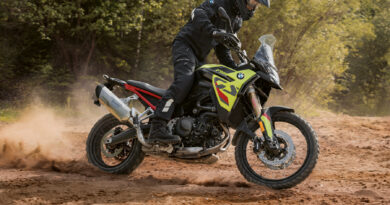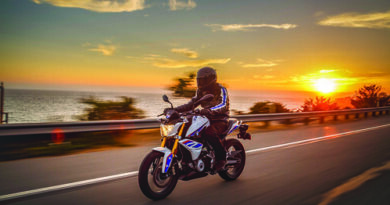BMW announces 2021 S, G Roadsters
Let’s get one thing straight: No matter how many times the hosts of BMW Motorrad’s worldwide streaming event announcing the new versions of the S 1000 R and G 310 R said it, neither of these bikes is naked in the traditional sense. They are, however, roadsters above reproach.
 Naked bikes are easy to spot – they have everything you need and nothing you don’t. Handlebar, tank, seat, forks, shocks, hand and foot controls, and wheels. No fairings, no cowls, no belly pans, no flyscreens, no extraneous panels, none of it are to be found on a true naked bike. Think of the difference between an R 90/6 and an R 90S. One is naked, one is not, and it’s easy to tell which is which. Even though both updated models look like fun, high-tech bikes, words are important and they’re not naked.
Naked bikes are easy to spot – they have everything you need and nothing you don’t. Handlebar, tank, seat, forks, shocks, hand and foot controls, and wheels. No fairings, no cowls, no belly pans, no flyscreens, no extraneous panels, none of it are to be found on a true naked bike. Think of the difference between an R 90/6 and an R 90S. One is naked, one is not, and it’s easy to tell which is which. Even though both updated models look like fun, high-tech bikes, words are important and they’re not naked.
The primary impetus behind these updates is to bring the models into compliance with Euro 5 emissions standards. Not every manufacturer is bothering; for example, rather than update the iconic YZF-R6 to come into line with the new regulations, Yamaha simply cancelled production of the model, replacing it with a track-only version which doesn’t have to adhere to road standards. Updating because regulations have changed isn’t always easy, but it does present an opportunity to take advantage of improved technology that didn’t exist or was prohibitively expensive the last time a particular model received a refresh or redesign.
2021 G 310 R
 The G 310 R, BMW’s first motorcycle made in India, has only been in production since 2018, so without the push of Euro 5, there wouldn’t have been much of a reason to update it so quickly. BMW didn’t squander the opportunity, however, even though the bike’s 313 cc single-cylinder engine retains its performance curve (34 bhp at 9500 RPM and 21 lb-ft of torque at 7500 RPM) and curb weight (350 lbs).
The G 310 R, BMW’s first motorcycle made in India, has only been in production since 2018, so without the push of Euro 5, there wouldn’t have been much of a reason to update it so quickly. BMW didn’t squander the opportunity, however, even though the bike’s 313 cc single-cylinder engine retains its performance curve (34 bhp at 9500 RPM and 21 lb-ft of torque at 7500 RPM) and curb weight (350 lbs).
The smallest Roadster in BMW’s lineup – though with its 31-inch seat height, some may scoff at calling the G 310 R “small” – now has LED lighting all around, with increased visibility from the new headlight and turn signals a giant plus. A daytime driving light is available in some countries, so check with your dealer about that. BMW has also added adjustable clutch and brake levers, allowing riders with smaller hands to control their motorcycles more safely and effectively.
One safety feature seen on an increasing number of BMW motorcycles is what they’re calling a “self-boosting anti-hopping clutch.” This is a lot of words to describe a fairly simple process – if you downshift too far and dump the clutch, the bike’s computer will reduce engine drag torque in a valiant attempt to help you stay upright. Also included as standard is an “electromotive throttle controller” (i.e. throttle-by-wire) and a computer subroutine to increase idle speed when necessary to prevent the bike from stalling. Putting this kind of advanced technology on a sub-$6,000 motorcycle is a big move for BMW, showing they are committed to safe riding at all price points.
Cosmetics didn’t get left on the design room floor; true to typical form, BMW has new color options available. The base colors for the G 310 R are Cosmic Black or Polar White; optional is a black and white bike with red accents, a red frame and red wheels, which, if we’re being honest, looks amazing. The white bike with blue accents (but a black frame and black wheels) still looks nice, but it’s not nearly as eye-popping as the black-white-red version.
The 2020 G 310 R in basic red or black started at $5,440; while BMW didn’t announce a price increase for the 2021 model, it’s safe to assume with Euro 5 considerations and the various upgrades that the next G 310 R could have a slightly higher price tag, inching a bit closer to $6,000.
2021 S 1000 R
 The 2021 S 1000 R is already available in BMW’s online configurator, and it starts at $16,440 in Racing Red (though for some reason, that color is not reflected on the website). Buyers can opt for the Style Sport (Hockenheim Silver Metallic with a matte copper metallic frame and side covers) or the M Motorsport (Light White Metallic with M red/blue/blue accents) for a flashier finish.
The 2021 S 1000 R is already available in BMW’s online configurator, and it starts at $16,440 in Racing Red (though for some reason, that color is not reflected on the website). Buyers can opt for the Style Sport (Hockenheim Silver Metallic with a matte copper metallic frame and side covers) or the M Motorsport (Light White Metallic with M red/blue/blue accents) for a flashier finish.
A number of the options mentioned in BMW’s press release about the new S 1000 R are not yet reflected on the website. They are:
- Comfort Package: Keyless Ride Light, USB charging port, heated grips and cruise control
- Dynamics Package: Riding Modes Pro, MSR, DBC, HSC Pro, Launch Control, Shift Assist Pro, DDC and a belly pan
- M Package: forged or carbon fiber wheels, lightweight (no doubt lithium-iron) battery, titanium muffler, M Endurance Chain, M Motorsport paint finish, M lap trigger code, M sport seat, and the M fuel cap
- Carbon Package: carbon fiber body panels (front fender, rear fender, chain guard and wind deflector)
- Milled Parts Package: hand levers, hand lever protectors, rider foot pegs, passenger foot pegs, all from the M line of parts
ABS Pro, cruise control, Ride Modes Pro, Gear Shift Assist Pro and Dynamic Traction Control (DTC) are either included as standard or available as options. Also standard on this bike are Automatic Stability Control (ASC), upside-down forks adjustable for compression and rebound damping (the rear shock is similarly adjustable) and BMW’s anti-hopping clutch technology as detailed above – all in all, a pretty stellar package for the money.
 What you get with the S 1000 R is possibly the most astounding-looking European roadster around. The 438-pound S 1000 RR puts out a claimed 165 bhp at 11,000 RPM and 84 lb-ft of torque at 9,250 RPM; you might be thinking 165 bhp is lame since it’s got the same engine in it as the S 1000 RR, which claims 207 bhp, but come on – even the men (and it was all men) giving the presentation online said a Roadster isn’t about straight-line power, it’s about owning the twisties in style and since we’re over here being honest with each other, most riders aren’t going to need 165 bhp anyway. What’s more important is how the bike is tuned, where the power is available, and to that end, BMW says the S 1000 R is meant to be ridden hard and – when appropriate – fast. The upside is the R has way fewer body panels to replace than the RR if (when?) you throw it down the road ahead of you.
What you get with the S 1000 R is possibly the most astounding-looking European roadster around. The 438-pound S 1000 RR puts out a claimed 165 bhp at 11,000 RPM and 84 lb-ft of torque at 9,250 RPM; you might be thinking 165 bhp is lame since it’s got the same engine in it as the S 1000 RR, which claims 207 bhp, but come on – even the men (and it was all men) giving the presentation online said a Roadster isn’t about straight-line power, it’s about owning the twisties in style and since we’re over here being honest with each other, most riders aren’t going to need 165 bhp anyway. What’s more important is how the bike is tuned, where the power is available, and to that end, BMW says the S 1000 R is meant to be ridden hard and – when appropriate – fast. The upside is the R has way fewer body panels to replace than the RR if (when?) you throw it down the road ahead of you.
Where the new S 1000 R really shines isn’t its raw power, it’s the new chassis. BMW based the frame and swingarm more closely on the RR and lightened them up, helping achieve a nice weight reduction for the 2021 model. The bike is narrower now, giving the rider a more tucked-in feel. The underslung swing arm comes directly from the RR, and the rear shock’s Full Floater Pro features move it away from the engine, keeping it cooler and thus functioning at a higher level as the riding itself heats up, not to mention improving tire life.
The S 1000 R also gets the new 6.5-inch TFT display from the RR, including the ability to customize the screens. For example, the Pure Ride screen gives the rider just enough information for normal road riding, while another choice adds items like lean angle and more. Adding the M package adds more display options, further enabling the rider to tweak their experience.
Like the G 310 R, the S 1000 R now features LED lighting all around, including the RR’s rear lights, which function as combined turn signals, tail lights and brake lights. Riders can add the Headlight Pro option, which an adaptive turning headlight on the bike, enabling riders to better see through turns in the dark.
The heart of the S 1000 R is the new engine, which is derived from the RR’s engine but lacks BMW’s ShiftCam technology. The top three gears have new, wider ratios, lowering engine speed and reducing fuel consumption without affecting performance.



